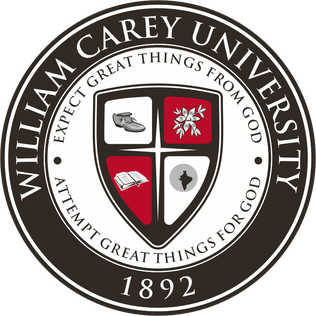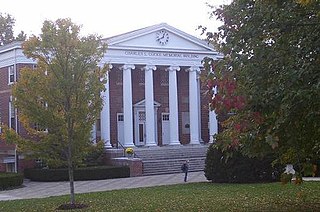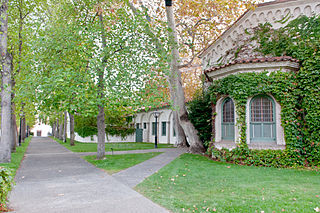Related Research Articles

Barnard College, officially titled as Barnard College, Columbia University, is a private women's liberal arts college in the borough of Manhattan in New York City. It was founded in 1889 by a group of women led by young student activist Annie Nathan Meyer, who petitioned Columbia University's trustees to create an affiliated college named after Columbia's then-recently deceased 10th president, Frederick A. P. Barnard. The college is one of the original Seven Sisters—seven liberal arts colleges in the Northeastern United States that were historically women's colleges.

Dartmouth College is a private Ivy League research university in Hanover, New Hampshire, United States. Established in 1769 by Eleazar Wheelock, Dartmouth is one of the nine colonial colleges chartered before the American Revolution. Emerging into national prominence at the turn of the 20th century, Dartmouth has since been considered among the most prestigious undergraduate colleges in the United States.
The Seven Sisters are a group of seven private liberal arts colleges in the Northeastern United States that are historically women's colleges. Barnard College, Bryn Mawr College, Mount Holyoke College, Smith College, and Wellesley College are still women's colleges. Vassar College became coeducational in 1969 and Radcliffe College was absorbed in 1999 by Harvard College and now offers programs in advanced study.

Deep Springs College is a private junior college in Deep Springs, California. With the number of undergraduates restricted to 26, the college is one of the smallest institutions of higher education in the United States. Though it offers an associate degree, most students transfer into a four-year college after completing their studies. Those enrolled pay no tuition and are given room and board.

Mixed-sex education, also known as mixed-gender education, co-education, or coeducation, is a system of education where males and females are educated together. Whereas single-sex education was more common up to the 19th century, mixed-sex education has since become standard in many cultures, particularly in western countries. Single-sex education remains prevalent in many Muslim countries. The relative merits of both systems have been the subject of debate.

Wells College was a private liberal arts college in Aurora, New York, located in the Finger Lakes region of New York. The college had cross-enrollment with Cornell University and Ithaca College. For much of its history it was a women's college. It was within the Aurora Village–Wells College Historic District, listed on the National Register of Historic Places. The college was closed by the board of trustees and president of the college at the end of the spring 2024 semester, citing financial difficulties. The closure process was expected to continue through the end of 2024.

Kirkland College was a small, private liberal arts women's college located in Clinton, New York, from 1965 to 1978. It was a female counterpart to Hamilton College, at that time all male, and its campus was adjacent to Hamilton's. It was named for Samuel Kirkland, who founded the Hamilton-Oneida Academy, origin of Hamilton College. It was not successful financially, so Hamilton absorbed Kirkland on June 30, 1978, has maintained its archives and financial endowment, and supports its alumnae community.
Hanover College is a private college in Hanover, Indiana, affiliated with the Presbyterian Church (USA). Founded in 1827 by Reverend John Finley Crowe, it is Indiana's oldest private college. The Hanover athletic teams participate in the NCAA Division III as a member of the Heartland Collegiate Athletic Conference. Hanover alumni are known as Hanoverians.

Phi Tau (ΦΤ) is a coeducational fraternity at Dartmouth College in Hanover, New Hampshire, USA. Founded in 1905 as the Tau chapter of Phi Sigma Kappa, the organization separated from the national fraternity in 1956 over a dispute regarding the segregationist membership policies of the national organization. The fraternity renamed itself Phi Tau Fraternity, and in 1972 became the first fraternity at Dartmouth to admit women student members. Today, Phi Tau Coeducational Fraternity is one of only three remaining, officially recognized coeducational Greek organizations on the Dartmouth College campus.

William Carey University is a private Christian university in Mississippi, affiliated with the Southern Baptist Convention and the Mississippi Baptist Convention. The main campus is in Hattiesburg and a second campus is in the Tradition community north of Biloxi.

Arcadia University is a private university in Cheltenham Township, Pennsylvania, with a Glenside mailing address. The university enrolls approximately 3,200 undergraduate, master's, and doctoral students. The 94-acre Glenside campus features Grey Towers Castle, a National Historic Landmark; the university also includes a campus in Christiana, Delaware, as well as several centers around the world.

Benedictine University is a private Catholic university with campuses in Lisle, Illinois, and Mesa, Arizona, United States. It was founded in 1887 by the Benedictine monks of St. Procopius Abbey in the Pilsen community on the West Side of Chicago. The institution has retained a close relationship with the Benedictine Order, which bears the name of St. Benedict, the acknowledged father of western monasticism.

Tennessee Wesleyan University (TWU) is a private Methodist university in Athens, Tennessee. It was founded in 1857 and is affiliated with the Holston Conference of the United Methodist Church. It maintains a branch campus in Knoxville, where it offers evening programs in business administration. It also conducts its nursing classes in Knoxville.
Brescia University is a private Roman Catholic college in Owensboro, Kentucky. It was founded as a junior college for women and is now a coeducational institution, offering undergraduate and master's programs.

The history of Cornell University begins when its two founders, Andrew Dickson White of Syracuse and Ezra Cornell of Ithaca, met in the New York State Senate in January 1864. Together, they established Cornell University in Ithaca, New York, in 1865. The university was initially funded by Ezra Cornell's $400,000 endowment and by New York's 989,920-acre (4,006.1 km2) allotment of the Morrill Land Grant Act of 1862.
The following is a timeline of women's colleges in the United States. These are institutions of higher education in the United States whose student population comprises exclusively, or almost exclusively, women. They are often liberal arts colleges. There are approximately 35 active women's colleges in the U.S. as of 2021.

Women's colleges in the Southern United States refers to undergraduate, bachelor's degree–granting institutions, often liberal arts colleges, whose student populations consist exclusively or almost exclusively of women, located in the Southern United States. Many started first as girls' seminaries or academies. Salem College is the oldest female educational institution in the South and Wesleyan College is the first that was established specifically as a college for women, closely followed by Judson College in 1838. Some schools, such as Salem College, offer coeducational courses at the graduate level.

Women's colleges in the United States are private single-sex U.S. institutions of higher education that only admit female students. They are often liberal arts colleges. There are approximately 26 active women's colleges in the United States in 2024, down from a peak of 281 such colleges in the 1960s.

Shimer College was founded in 1852, when the pioneer town of Mt. Carroll, Illinois, lacking a public school, incorporated the Mt. Carroll Seminary with no land, no teachers, and no money for this purpose.
References
- ↑ Hanover College Board of Trustees Minutes, Hanover College, HC 1
- ↑ Cherrington, Ernest Hurst (1928). "McWHIRTER, LUELLA FRANCES (SMITH)". Standard encyclopedia of the alcohol problem. Vol IV. Kansas-Newton. Westerville, Ohio: American Issue Publishing Co. p. 1641. Retrieved 1 April 2024– via Internet Archive.
 This article incorporates text from this source, which is in the public domain .
This article incorporates text from this source, which is in the public domain .